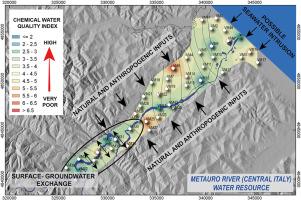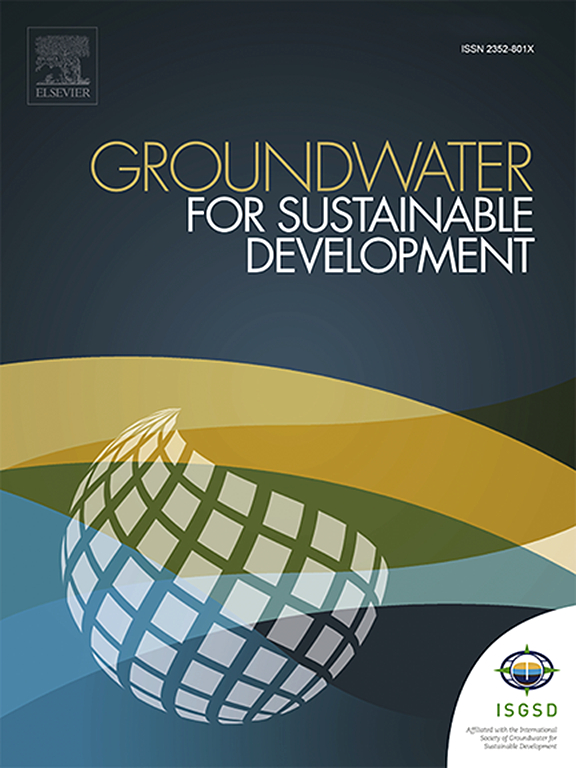Assessing anthropogenic and natural influences on water quality in a critical shallow groundwater system: Insights from the Metauro River basin (Central Italy)
IF 4.9
Q2 ENGINEERING, ENVIRONMENTAL
引用次数: 0
Abstract
This work aims at the hydro-geochemical and isotopic characterization of the water resource (surface water and shallow phreatic aquifer) of the Metauro River catchment (Marche, Central Italy). The waters of the Metauro River area represent a fundamental resource exploited daily for drinking, agricultural, and industrial uses. The anthropic pressure exposes the water resources to depletion and quality degradation risks, making the study area of high scientific and social interest. The hydro-geochemical approach revealed that the interaction between water and local lithologies led to Ca2+-HCO3- compositions, with less frequent Na+(K+)-Cl- and Ca2+-Cl- hydrofacies and variable salinity (up to 55 meq/L). Most waters showed natural (e.g., halite and evaporite contribution) and anthropogenic (sewage, septic tanks, manure, urban wastewater, and industrial effluents contribution) inputs confirmed by both Na+, Cl−, NO3−, and SO42− enrichments and high Cl/Br ratios. The anthropogenic contributions is further confirmed by the relatively high contents of TPTEs (Total Potentially Toxic Elements), even though these elements individually present values below the Italian Normative Legislative limit. Geochemical issues are mitigated during the year when the surface aquifer is recharged by the river, characterized by a better overall chemical quality. The occurrence of this relationship is of interest to the local authorities in charge of the water resource management. In fact, groundwater exploitation could be increased during specific periods, thus decreasing the anthropic pressure on the river waters, usually exploited for drinking purposes even during the summer seasons when the hydrometric levels drastically drop. The adopted multidisciplinary approach provides an effective tool for accurately determining groundwater processes and can be helpful in improving the balanced and sustainable management of water resources in coastal and non-coastal plains.

评估人类活动和自然因素对重要浅层地下水系统水质的影响:梅陶罗河流域(意大利中部)的启示
这项研究旨在对梅陶罗河流域(意大利中部马尔凯省)的水资源(地表水和浅层含水层)进行水文地球化学和同位素分析。梅陶罗河地区的水是一种基本资源,每天都被用于饮用、农业和工业用途。人类活动的压力使水资源面临枯竭和水质下降的风险,因此该研究区域具有很高的科学和社会价值。水文地球化学方法显示,水与当地岩性之间的相互作用导致 Ca2+-HCO3- 组成,Na+(K+)-Cl- 和 Ca2+-Cl- 水相较少,盐度多变(高达 55 meq/L)。大多数水域都有自然(如卤石和蒸发岩)和人为(污水、化粪池、粪便、城市污水和工业废水)输入,Na+、Cl-、NO3- 和 SO42- 的富集以及 Cl/Br 的高比率都证实了这一点。尽管这些元素的单个值低于意大利规范性立法限值,但相对较高的 TPTEs(潜在有毒元素总量)含量进一步证实了人为因素的影响。在地表含水层得到河流补给的年份,地球化学问题会得到缓解,因为这一年的整体化学质量较好。负责水资源管理的地方当局对这种关系的发生很感兴趣。事实上,在特定时期可以增加地下水的开采量,从而减少人类对河水的压力,因为即使在水文水位急剧下降的夏季,河水也通常被用作饮用水。所采用的多学科方法为准确确定地下水过程提供了有效工具,有助于改善沿海和非沿海平原水资源的平衡和可持续管理。
本文章由计算机程序翻译,如有差异,请以英文原文为准。
求助全文
约1分钟内获得全文
求助全文
来源期刊

Groundwater for Sustainable Development
Social Sciences-Geography, Planning and Development
CiteScore
11.50
自引率
10.20%
发文量
152
期刊介绍:
Groundwater for Sustainable Development is directed to different stakeholders and professionals, including government and non-governmental organizations, international funding agencies, universities, public water institutions, public health and other public/private sector professionals, and other relevant institutions. It is aimed at professionals, academics and students in the fields of disciplines such as: groundwater and its connection to surface hydrology and environment, soil sciences, engineering, ecology, microbiology, atmospheric sciences, analytical chemistry, hydro-engineering, water technology, environmental ethics, economics, public health, policy, as well as social sciences, legal disciplines, or any other area connected with water issues. The objectives of this journal are to facilitate: • The improvement of effective and sustainable management of water resources across the globe. • The improvement of human access to groundwater resources in adequate quantity and good quality. • The meeting of the increasing demand for drinking and irrigation water needed for food security to contribute to a social and economically sound human development. • The creation of a global inter- and multidisciplinary platform and forum to improve our understanding of groundwater resources and to advocate their effective and sustainable management and protection against contamination. • Interdisciplinary information exchange and to stimulate scientific research in the fields of groundwater related sciences and social and health sciences required to achieve the United Nations Millennium Development Goals for sustainable development.
 求助内容:
求助内容: 应助结果提醒方式:
应助结果提醒方式:


